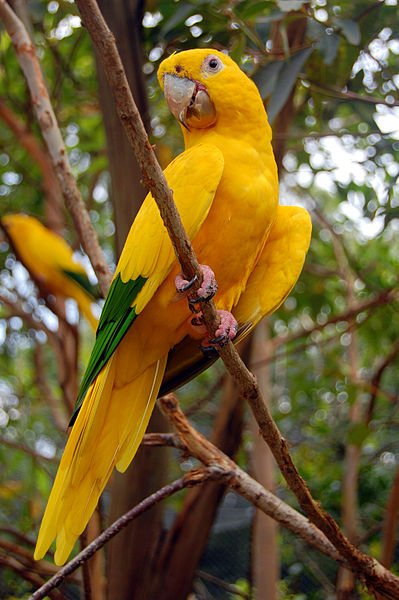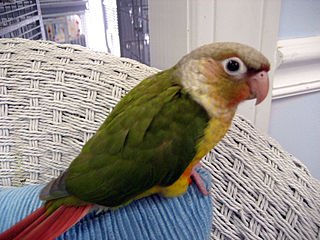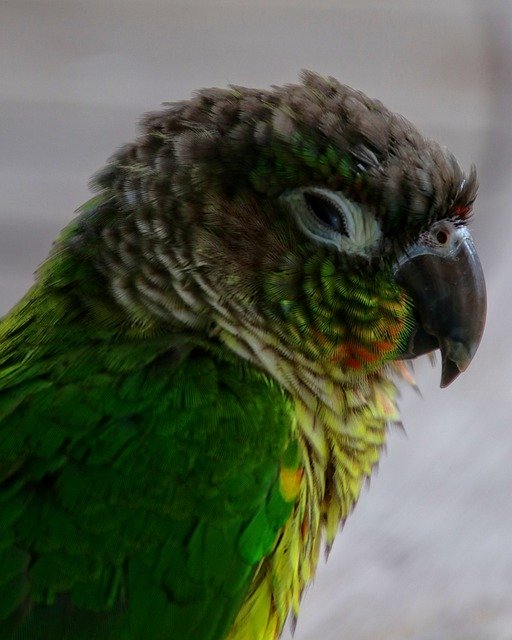The Queen of Bavaria Conure or better known as the Golden Conure owes his name to the rich golden color plumage. Often called the Golden Parakeet, the bird is, undoubtedly, stunning. Golden Conure is a parrot native to Northeastern Brazil. They are commonly found along the Southern Amazon River.
Scientifically named as Guaruba Guarouba from their genus Guaruba, they were long recognized as being from the genus Aratinga Guarouba. These medium-sized birds can measure anywhere from 13 to 14 inches. The wingspan ranges from 208 to 218mm depending on the bird’s gender. The weight of a golden conure can lie between 250 to 275 grams approximately.
Unfortunately Golden Conure is on https://www.iucnredlist.org/ red list as threatened specie. Mostly because of its habitat destruction. And hunting in its native area where it is considered as pest.
Golden Conure Conure Lifespan
Generally, in the wild, golden conures enjoy their life for around 20 years. They stay on tree-tops and eat a varied diet of fruits, buds, flowers, and seeds. When in captivity, golden conures can live longer than in the wild. The lifespan of a Golden Conure has been averaged at 23.5 years in captivity. However, good care and a balanced healthy diet can help them live up to 30 years. A period of 30 years is known as the maximum lifespan of golden conures. Turning 25 often brings them numerous health concerns.
Golden Conure Conure Colors
Golden conures are easily recognized from their shiny golden plumage. But this is not the only color he proudly displays. The striking tropical green outer wings make them unmissable to adore. A horn-colored beak, brown irises, and pink feet and legs make them a color canvas. They have a customary light pink bald ring around their eyes.
All these color additions to a yellow plumage make these birds look elegant and exotic at the same time.
The baby golden conure is recognized by their green upper tail, neck, and head along with brown legs. The body color of a baby golden conure will show a yellow plumage only after a few weeks.
Golden Conure Conure Breeding
Golden Conures are ready to breed once they are 3 years old. Before this age, breeding must be avoided as they are infamous for laying infertile clutches until 7 or 8 years of age. Mature golden conures tend to practice a good breeding process. The breeding season starts in November and ends in the month of February.
A single Golden Conure must be kept in the cage measuring 3ft×3ft×3ft. But for breeding purposes, the pair should be kept in a larger cage to offer individual space to both the male and female. When keeping a golden pair for breeding together, a 12ft×6ft×6ft sized cage would be ideal.
Golden Conures will need privacy during their reproductive season. An admirable nest box could be of the dimensions 9″×16″×12″. Preferably, this nest box must be kept high inside the cage, otherwise, these conures can get aggressive at times.
Golden conures are prolific once they start to breed. The female conure lays 4 eggs on an average and up to 3 consecutive clutches per year. Both parents guard the eggs aggressively. The incubation time is around 30 days and both the parents are actively involved in the process and take turns to hatch them.
The eggs have a white shell and turn darker within a week. The feathers of baby golden conure start to develop by the end of the third week. The Golden Conure pair resumes the breeding once the babies are taken away from them.
Golden Conure Conure Talking Ability
‘Golden Conures can talk’ is an understatement. These birds are extremely passionate about talking. They can be trained very quickly for common words and phrases. And with a little more time and dedication to their speech training, they have reported excellent vocabulary memorizing skills. To top that, they can also master to speak with context.
The talking abilities don’t end here. Golden Conures are skilled mimics. They can perfectly mimic the most common sounds such as beeps, kisses, and barks. They also love music and can be seen trying their hand at singing at times. And they make sure to add fun to it with their hidden talent of dancing.
Read about Best talking parrots here:
https://parrotquaker.com/parrots-and-their-talking-abilities/
Sounds that can be made by golden conures include chattering, vocalizing, and mimicking. The beloved parrot talk, mumbling, resembles human speech. They are more likely to be talkative parrots.
Are Golden Conures Noisy?
The noise level of golden conures can be moderate to loud. The signature sound of golden conures can be a high-pitched screech. Whenever a golden conure wants attention or is excited, they prefer screeching. They also make grating noises and screams for mating season.
Though noisy in general, they stay calm when tamed. That said, Golden conures noise completely depends on the household atmosphere in which they are living. If they live in a house with a lot of noise, they become louder to compete and win over those sounds. This behavior is very typical of conures in general. So, to keep the golden conure quiet, offer him a quiet and peaceful ambiance to mimic.
Golden Conure Gender Difference
Golden Conures are monomorphic which means one cannot identify the gender of the bird just by looking at a Golden Conure. The male and the female bird look the same, especially for not-so-keen eyes. However, there are minor differences between the male and female conure that can only be observed by the experts:
Size and weight- The physical taxonomy of the male Golden Conure has always shown them as slightly larger and heavier than their female counterparts. This also holds while measuring their wingspan. The females are always on the lower spectrum of the comparison scale.
Behavior- A behavioral difference that is known to tell Golden Conure sex apart is the level of noise produced by both the genders. The male golden conures are quiet and don’t talk too much, whereas hearing a female golden conure may require ear protection. She can be very noisy and can make a painful blend of several noises. The loudness of a female golden conure is known to bowl over her other female cousin conures.
Scientific Testing
To find accurate results that describe the gender difference between a male and female golden conure, there are no such exact factors like the ones mentioned above. DNA sexing is the only option to do it without being on the wrong side of gender determination. The DNA sexing for a golden conure can be done either with a feather sample or a blood sample.
One can take the sample by himself at home or can ask an experienced breeder to take the sample. The samples must be taken in a prescribed manner and a blood clotting medication must be kept handy at the time of taking a sample. The sample should be sent to the lab immediately for testing. The reports will tell accurately if the conure is a male or female.
Golden Conure Diet
The balanced diet of golden conures contains a healthy mix of vitamins and minerals. Golden Conures get the required amount of nutrients from a mixed diet of vegetables, fruits, sprouts, seeds, and nuts. In the wild, they feed on a diet which is a mix of fruits and seeds. In captivity, they must be served a wholesome diet full of nutrients including:
- Fresh fruits like apples, mangoes, berries, bananas, grapes, etc;
- Vegetables like winter squash, pumpkin, carrot, broccoli, etc.
- Leafy greens like collard greens, kale, spinach, beet greens, etc.
- Brown rice
- Cooked whole-grain pasta
- Sprouted grains and seeds like chia, quinoa, maize, safflower, etc.
- Pellets
- Wheat bread with low-fat butter or almonds
- Cracked walnuts or almonds as treats
- A bit of sunflower seed or a healthy mix of such seeds
The number of items they eat in captivity is far higher than in the wild. The fatty components in a golden conure’s diet always vary. Hence, a diverse diet plays an impressive role in a golden conure’s life. Complementing the seeds with wholesome fruits and vegetables reduces the impact of such fatty components.
As Golden Conures must have proteins in their food, the cooked corn, pulses, and beans can also be a good add-on. To add calcium, especially for the breeding hens, add cuttlebone to their chewing routine.
Provide the bird a freshwater that is of drinkable quality. It not only keeps the bird hydrated but also regulates all his body functions properly along with maintaining optimum body temperature.
Do not serve anything toxic to the bird, like:
- Caffeine
- Alcohol
- Chocolate
- Carbonated drinks
- Pitted fruits like avocado
- Onion
- Garlic
- Mushrooms (certain toxic varieties)
- Seeds of fruits like apples.
Only a healthy diet will allow the golden conure to live longer and healthier.
Summing Up
Golden Conures have always been a prominent pet. They are not loud and can be ideal pets for the people who live in small apartments. One must be sure about committing his 20 to 25 years to raise this bird healthily. These birds love the company. Add a few of their favorite toys and a lot of love to gain their love and companionship.
Feature Photo under: https://creativecommons.org/licenses/by-sa/3.0/deed.en




